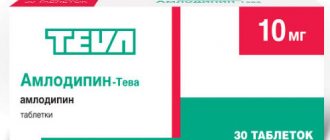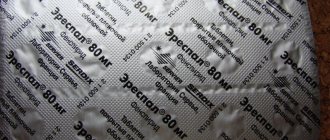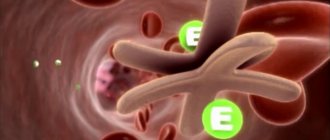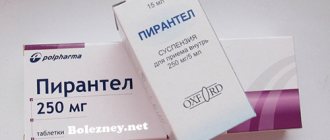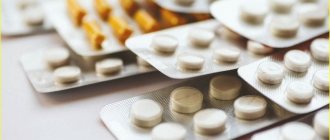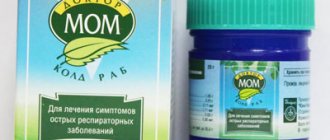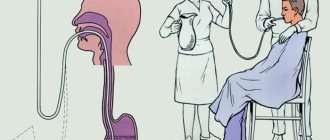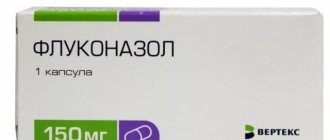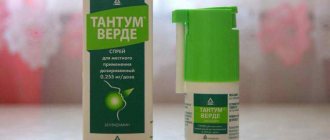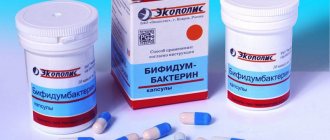Diseases of the gastrointestinal tract occur at different ages. Most often, adults who are independently responsible for their lifestyle and nutrition suffer from them. Their appearance in childhood is not always associated with an abundance of junk food in the diet. The largest percentage of recorded digestive disorders occurs during the introduction of complementary foods, as an individual reaction of an organism that is not yet ready. In this case, and in the presence of chronic gastrointestinal diseases in a child, pediatricians are forced to prescribe enzyme preparations. Pancreatin is often used to treat children due to the variety of dosages (it is more convenient to calculate the required number of tablets) and fewer side effects.
9Contraindications
Despite the fact that the drug contains enzymes that are closest in biochemical composition to those normally produced by the human pancreas, this drug is not suitable for everyone.
The active substances included in its composition are isolated from the gastric juice and bile of pigs. Porcine pancreatin causes allergies in some patients. Other contraindications include:
- pancreatitis - acute or chronic form in the acute stage;
- liver failure of various etiologies;
- intestinal obstruction;
- hepatitis;
- disturbances in the outflow of hepatic bile (obstructive jaundice);
- accumulation of purulent fluid in the cavity of the gallbladder (complication of cholelithiasis - empyema);
- hepatitis.
Due to the specific nature of enzyme activity in the first years of life, the tablets are contraindicated in children under 3 years of age. It is also necessary to take into account the presence of lactose among the excipients of the drug. Patients with intolerance to this natural sugar are advised to choose an alternative enzyme agent.
Indications for use for children
Pancreatin is suitable for children who have problems with digestion and absorption of food due to the following reasons:
- pancreatitis (inflammation of the pancreas) beyond the acute stage;
- cystic fibrosis;
- after removal of part of the stomach, liver, pancreas or stomach;
- after cholecystectomy (resection of the gallbladder);
- during the recovery period after irradiation of the gastrointestinal tract;
- errors in nutrition (abundance of fatty, spicy, fried foods).
Pancreatin is also prescribed to children before examination of the gastrointestinal tract (X-ray, ultrasound).
Basic regimens and dosages
In case of true pancreatic insufficiency, the dose of the drug depends on the diet. The doctor determines it based on the patient’s condition, tests and the amount of fat consumed with food per day. For every gram of fat in the diet you need 4000 units. lipases.
Pancreatin Forte with an activity of 14,000 units. Adults are prescribed 1-2 tablets (14-28 thousand) three times a day. If there is no effect, then the dosage is increased to 42 thousand units per dose. A complete replacement of 400,000 units is acceptable. This is the norm produced by the pancreas per day. Typically, the maximum dose is calculated at 20,000 per kg of body weight.
Pancreatin Forte
Comparing the composition of Pancreatins with the prefix “Forte”, we come to the conclusion that not all drugs justify the name due to the strength of their enzyme activity. You should not count on this indicator when choosing a product. Pharmaceutical production technologists refer to strengthening the protective shell. Therefore, more enzymes are delivered to the intestines. It is impossible to measure them.
Moderate doses are suitable for treating children and adolescents. It is safer to take them on your own against the background of overeating or diet violations.
Pancreatin-Health
Instructions for use of “Pancreatin-Health Forte 14000” recommend calculating the frequency of doses and the number of tablets with a minimum dose of lipolytic activity of 14 thousand units. The tablets cannot be crushed into pieces or ground into powder. If a lower dosage is needed, it is better to choose another drug.
The summary warns about drinking more fluid to prevent possible constipation.
Composition of the drug
The instructions for use describe “Pancreatin 25 IU” as a very effective drug, which includes the following components: active substance - pancreatin, gelatin, milk sugar, calcium stearate, titanium dioxide, petroleum jelly, azorubine dye, potato starch, cellacephate and polysorbate.
Many patients ask the question: what does the abbreviation ED stand for? It actually stands for a unit of action.
Directions for use and doses
“Pancreatin” affects not only the absorption of food, but also various pharmacological agents. Therefore, if you plan to use other medications simultaneously with the drug, you should inform a specialist about this and consult with him. It is not advisable to use medications in parallel with Pancreatin that contain magnesium or calcium, as well as alcohol-containing solutions, which can weaken the effectiveness of the drug.
People with diabetes should be careful when using this medication. This is explained by the fact that the enzymes contained in the tablets negatively affect drugs that reduce blood glucose.
But antibacterial drugs and sulfonamides in water are absorbed much better and faster by the influence of enzymes. Those who use the drug for a long time should simultaneously use iron-containing medications, because enzymes complicate the process of absorption of this element.
Patients with cystic fibrosis should also take the medicine carefully. In this case, only a doctor can calculate the correct dosage, and it directly depends on the frequency of food intake and its quality
The tablets should be taken orally, swallowed and washed down with water (preferably even fruit juices). It is best to take the medicine during or immediately after meals.
It is impossible to exceed the maximum possible daily dose (in terms of lipase it is 1.5 thousand - 2 thousand units per kilogram of weight).
For adults, the average dose of the drug is 150 thousand units per day, if practically no pancreatic secretion is secreted at all - 400 thousand, which corresponds to the daily needs of an adult.
The duration of treatment varies: from taking a pill once or using the drug for several days to using the medication for months and sometimes years (if the patient needs constant replacement therapy).
The instructions for the pharmacological product state that adults need to take 3-4 tablets in the morning, lunch and evening. Consuming larger quantities can only be prescribed by a doctor.
The medication is also prescribed before an x-ray or ultrasound. In this case, the patient should take 2 tablets 2-3 times a day.
Children over three years of age take 100 thousand units per day, divided into 3-4 doses.
If the dosage is not observed, the following symptoms may occur:
- When consuming high doses over a long period of time, hyperuricosuria occurs.
- When using high doses in patients with cystic fibrosis, strictures in the colon occur. Children experience constipation.
"Pancreatin": instructions for use
Adults are recommended to take tablets 3-6 times a day. Since this drug is intended to replace enzymes that are involved in the digestion of food, its intake depends on it. It is very important when to drink Pancreatin: before or after meals. Most often it is recommended to take it with meals. The tablets are swallowed whole without chewing. You can drink them with clean water, milk or tea. With this intake, enzymes will enter the intestines along with food, since the shell dissolves only there. And the drug will act more effectively.
Instructions for use of Pancreatin tablets for adults recommend consuming no more than 16-18 tablets per day. Most often they drink 2-4 pieces 3-6 times a day, depending on the number of meals and the severity of the patient’s condition. The duration of treatment may also vary. In mild cases, it is enough to take Pancreatin for several days; most often it is prescribed for a course of 2-3 months. Sometimes the patient needs constant replacement therapy, then the drug is taken for several years.
Indications and contraindications
When feeding or lactation, a young mother may be bothered by certain problems that necessitate the need to take auxiliary substances to establish the normal functioning of the gastrointestinal tract. These include:
- Inflammatory processes of the liver, stomach, gall bladder;
- Pancreatitis;
- Increased bloating, gas formation;
- Partial removal of the stomach, pancreas, as a result of surgery;
- Excessive consumption of fatty foods;
- As preparation for conducting surveys;
- Insufficiently active lifestyle.
The dosage and course of treatment are prescribed by a specialist. There are certain admission restrictions:
- Intolerance to the components of the drug;
- Hepatitis;
- Intestinal obstruction;
- With exacerbation of pancreatitis.
A nursing mother should closely monitor the baby's reaction to taking the drug. The child may experience bloating, disruption of the digestive system, diarrhea, and problems with stool. The presence of any symptom is a reason to stop taking the medicine.
Overdose symptoms and side effects
There are two groups of side effects of the drug: common and rare.
- The first includes a violation of the amino acid metabolism of purines and, as a result, hyperuricemia and hyperuricuria with the formation of urolithiasis, stricture or narrowing of natural intestinal bottlenecks (ileocecal flexure, splenic and hepatic angles), discomfort or pain in the epigastric region, heaviness in the abdomen.
- The second group includes skin allergic reactions in the form of itching, burning, and the appearance of various rashes. In rare cases, it is possible to develop an attack of suffocation that resembles bronchial asthma, urticaria or anaphylaxis. In isolated manifestations, the opposite effect from taking the drug is observed: heartburn, increased nausea or vomiting, frequent belching, diarrhea, which is replaced by constipation, increased flatulence.
In case of an overdose of Pancreatin by dose or time (long-term continuous course of therapy), partial or complete (less often) dynamic and strangulation intestinal obstruction may develop. If an emergency condition is suspected, immediate hospitalization of the patient in the surgery department is necessary to correct the restoration of intestinal patency.
Average price for Pancreatin Forte and Pancreatin-Zdorovye. Rules for dispensing from pharmacies
List of drug analogues with prices
We selected Pancreatin Forte analogues based on their intended purpose and composition.
In Mezim, a German drug from the number of enzymes: 3.5 thousand units. lipase, 4.2 thousand units. amylase and 250 - protease. There are 3 forms of Mezim Forte with lipase dosages of 3500, 10000, 20000 units. The tablets are coated with a protective coating. The composition corresponds to one of the drugs from the Pancreatin Forte group. The minimum price is about 80-100 rubles.
Gastenorm forte, supplied by India, is also available in film-coated tablets. Lipase activity 3,500 units. Price - 107 rub.
Panzinorm is a drug in capsules, produced by the Slovenian company KRKA, according to the dosage you can choose 10,000 and 20,000. Price - about 100 rubles.
Creon is a medicine from the German company Abbot Products, known for dosages of 10,000, 20,000 and 40,000 units. by lipolytic activity. It is the best representative of granular products. Inside the capsule there are microspheres with an additional shell. In the treatment of young children, it is allowed to open the outer shell and dilute the microspheres in water. Used to compensate for pancreatic insufficiency when high doses are required. The price depends on the composition, you can buy it for 228-600 rubles.
Pangrol is a capsule drug from Berlin Chemie (Germany) in 10,000 and 25,000 units, there is a tablet form in 20,000 units. with acid-resistant coating. Average price - 540 rubles.
Micrazim is a Russian capsule drug produced, you can choose 10,000 and 25,000 units. Costs 230 rubles.
Penzital - produced in tablets by India, SHREYA LIFE SCIENCES, containing 6000 units of lipase, 4500 units of amylase, 300 units of protease. Price from 57 rubles. per package.
Enzistal-P is also an Indian drug in enteric-coated tablets from TORRENT PHARMACEUTICALS; hemicellulase and dry bile are added to pancreatin. In terms of composition, it is not considered a complete analogue. Price 66 rub.
Analogs of Pancreatin Forte are necessary for allergic reactions, choosing a convenient dosage.
Release form and composition
The following dosage forms of Pancreatin are produced:
- Enteric dragees: smooth, brown, with a shiny surface (in blisters of 10 pcs.; 5 blisters in a box);
- Enteric-coated tablets (in cans or bottles of 60 pcs., blister packs of 10 pcs.; 1 can, 1 bottle, 1, 2, 3, 5 or 6 packs in a cardboard pack).
1 tablet contains:
- Active ingredient: pancreatin with enzyme activity - proteolytic (200 FIP units (international units of enzymatic activity), amylolytic (3500 FIP units), lipolytic (4300 FIP units);
- Auxiliary components: chocolate brown dye, shellac, gum arabic, carnauba wax, white wax, diethyl phthalate, cellulose acetate phthalate, talc, sucrose, magnesium stearate, starch, glucose, lactose, polyvinylpyrrolidone.
1 tablet contains the active ingredient: pancreatin - 500 mg (with amylase activity - 12500 units (action units), protease - 12500 units, lipase - 1000 units).
Pharmacodynamics of the drug
"Pancreatin Forte", delivering additional enzymes to the alkaline environment of the intestines, ensures normal digestion and proper breakdown of food - in particular, proteins, fats and carbohydrates to their simplest components. Thus, the enzyme preparation increases the absorption of nutrients in the small intestine.
The composition of the drug, in addition to additional components, includes the enzymes alpha-amylase, lipase, trypsin and chymotrypsin. Each of them is responsible for the breakdown of individual substances.
Lipase breaks down fats into fatty acids and monoglycerides. Amylase hydrolyzes starch into its constituent parts - initially to dextrins, and then to maltose. Proteins are broken down into amino acids and polypeptides by proteases. The drug also has a mild analgesic effect on the pancreas. A special shell protects pancreatic enzymes from breakdown in the stomach. Half an hour after taking the drug, its greatest enzyme activity is observed.
Pancreatin: composition and principle of action
Pancreatin is produced from the pancreas of pigs and cattle. It contains the enzymes amylase (digests carbohydrates), lipase (digests fats), proteases (digests carbohydrates).
The main active ingredient in the drug is pancreatin , which, in turn, contains a complex of enzymes:
- Lipase – promotes the breakdown of fats, 1 tablet contains from 10,000 to 25,000 IU of the enzyme.
- Amylase is responsible for the breakdown and absorption of carbohydrates; 1 tablet contains from 9000 to 22500 IU of the enzyme.
- Proteases - once in the intestines, they help break down proteins into amino acids; 1 tablet of the drug contains from 500 to 1250 IU of the enzyme.
as excipients in tablets, capsules or dragees:
- Magnesium stearate;
- Cellulose;
- Silica;
- Sodium chloride;
- Starch;
- Propylene glycol;
- Povidone;
- Polyacrylate;
- Dye.
In general, the drug, thanks to enzymes, improves digestion , helps get rid of bloating, loose stools, and heaviness in the stomach that occurs after eating. Pancreatin includes the enzyme system of intestinal microflora in the process of food digestion.
Pancreatin release forms and names
Various pharmaceutical companies produce pancreatin in the form of tablets, capsules and dragees under the names: biozyme, vestal, gastenorm, zymet; Creon, lycrease, mezim, micrazim, pangrol, panzim, panzinorm; pancreazym, pancrealipase, pancreaal, pancrenorm, pancreon, pancitrate; pensital, prolipase, trienzyme, festal, enzistal, hermital.
Indications for use
This drug has proven itself to be an excellent remedy for indigestion in adults and children. But the instructions say that there are many more indications for its use:
- Chronic pancreatitis.
- Insufficiency of the secretory function of the pancreas.
- Inflammation of the liver and gastrointestinal tract.
- Dystrophic changes in the digestive system.
- Cystic fibrosis.
- Bloating.
- Postoperative therapy after gastrectomy.
- Preparation for examination of the digestive organs.
- Late pancreatitis that occurs after transplantation.
- Indigestion.
- Flatulence.
- Non-infectious diarrhea.
- Postoperative therapy after removal of the pancreas.
- Intestinal inflammation with impaired production of digestive enzymes.
- Error in nutrition, overeating.
In addition to the above, pancreatin tablets will be useful for weight loss , as they help improve digestion and normalize the functioning of the gastrointestinal tract, and therefore speed up metabolism.
6How to take Pancreatin Forte
The drug can be used as a first aid remedy (for example, for overeating) or taken in courses to compensate for chronic enzyme deficiency.
Pancreatin forte 14000 can be used as a first aid remedy for overeating.
Dosage
Determined by the attending physician taking into account the patient’s age and degree of deficiency. The average adult dose is 150,000 units per day. This amount of active substance is contained in 3-4 tablets. In severe cases, at the discretion of the doctor, the dose can be increased to 400,000 units per day. Children over 3 years old are prescribed no more than 100,000 units of lipase per day - moreover, this dose must be divided into 3-4 doses.
Duration of use
Determined individually. So, to eliminate the consequences of overeating, 2-3 tablets are enough, which are taken at a time, but with chronic pancreatitis, enzyme replacement may be required constantly.
To eliminate the consequences of overeating, 2-3 tablets taken at a time are enough.
Groups of pancreatic enzyme preparations
Pharmacies offer many types of enzyme preparations. They can be divided into groups:
- pancreatin tablets;
- enzymes containing not only pancreatin, but also bile;
- pancreatin in the form of microspheres (balls) or microtablets enclosed in a shell that is insoluble in the stomach.
Sometimes adsorbents (for example, simethicone) are added to enzyme preparations, which reduce gas formation and bloating.
Let us say right away that there is no need to use enzymes with the addition of bile for pancreatitis. They cause increased work of the gland, while during an exacerbation, on the contrary, the gland needs rest. In addition, when prescribed in an adequate dose, drugs containing bile cause diarrhea. Medicines containing bile are indicated for healthy people if there is an error in their diet. These are products such as Festal, Digestal, Biofestal, Normoenzyme, Normoenzyme Forte, Ferestal, Enzistal.
So, for the treatment of pancreatitis, medications are intended that include only pancreatin, possibly with the addition of simethicone or dimethicone, in the form of tablets or capsules. Let's talk about how they differ and when it is better to use one form or another.
11Compatibility with alcohol
It is recommended to completely abstain from drinking alcohol for 8-12 hours before and after taking the tablets. If the medicine was taken as a course, alcohol must be excluded for 3-30 days, depending on the instructions of the attending physician.
The accumulation of a large amount of bile becomes a barrier that does not allow the substances produced by the pancreas to pass through. The destruction of the bile system by highly active enzymes begins, which contributes to the development of pancreatitis.
Patients who still allow themselves to have a glass in honor of the holiday are advised to completely stop drinking alcohol and drink as much clean water as possible within 4-5 hours.
It is recommended to completely abstain from drinking alcohol for 8-12 hours before and after taking the tablets.
Description of the active substance PancreatinPancreatin.
Formula, chemical name: enzyme preparation from the pancreas of cattle and pigs. Pharmacological group: metabolism/enzymes and antienzymes. Pharmacological action: replenishing the deficiency of pancreatic enzymes.
Pharmacological properties
Pancreatin contains excretory enzymes of the pancreas: alpha-amylase, lipase, chymotrypsin, trypsin, promotes the breakdown of proteins into amino acids, fatty acids and glycerol of fats and monosaccharides and dextrins of starch, normalizes the processes of food digestion. The enzymes contained in pancreatin are protected by the shell from the influence of gastric juice and are released only in the alkaline environment of the small intestine. Trypsin inhibits stimulated pancreatic secretion in the upper part of the small intestine, thereby determining the analgesic effect of pancreatin.
Indications
Digestive insufficiency in violation of the exocrine function of the pancreas: chronic pancreatitis, cystic fibrosis, dyspepsia, pancreatectomy, flatulence, Roemheld syndrome; chronic diseases in the biliary tract and liver system; intestinal infections; disorders of food absorption (accelerated passage of food through the intestines, condition after resection of the small intestine and stomach, errors in the diet when taking indigestible, unusual or fatty foods, with nervousness, and others); for intestinal degassing before diagnostic studies (ultrasound, x-ray and others).
Method of administration of pancreatin and dose
Pancreatin is taken orally, without chewing, before meals, with a large amount of alkaline liquid (fruit juice, water). Depending on the severity of digestive disorders, the dose is set. Typically, 3–6 times a day, 0.25–0.5 g. The duration of therapy ranges from several days (for example, in case of digestive disorders due to errors in diet) and up to several months and even years (when replacement therapy is necessary ).
It is not recommended to exceed the daily dose of pancreatin, especially in patients with cystic fibrosis. For long-term treatment, it is necessary to prescribe iron supplements. Disturbances from the digestive system may develop in patients with hypersensitivity to pancreatin, or in patients with a history of intestinal resection or meconium ileus.
Contraindications for use
Hypersensitivity (including pork intolerance), exacerbation of chronic pancreatitis and acute pancreatitis.
Use during pregnancy and breastfeeding
The use of pancreatin during pregnancy is possible if the expected effects of treatment in the mother are higher than the possible risk to the fetus (the safety of using pancreatin during pregnancy has not been sufficiently studied). The use of pancreatin is not contraindicated during breastfeeding.
Side effects of pancreatin
Digestive system: diarrhea, discomfort in the stomach, constipation, nausea, symptoms of intestinal obstruction;
metabolism: with prolonged use of high doses of the drug, the development of hyperuricosuria and an increase in the content of uric acid in the blood plasma is possible;
other: allergic reactions, perianal irritation.
Interaction of pancreatin with other substances
Pancreatin reduces iron absorption (especially with prolonged use). When using Pancreatin together with antacids that contain magnesium hydroxide and/or calcium carbonate, the effectiveness of Pancreatin may be reduced.
Overdose
In case of an overdose of pancreatin, the following develop: hyperuricemia, hyperuricosuria, constipation is possible in children. Discontinuation of the drug and symptomatic therapy are necessary.
Characteristics of Mezim and Pancreatin
We present an overview of enzyme medications based on the following criteria:
- Efficiency. If the drugs are prescribed according to the condition, they have a positive effect on the body. Pancreatin is effective in treating minor disorders and does not adversely affect infants. Mezim has a large dosage of the active substance, so it is recommended in severe cases of the disease. Very often, doctors prescribe enzyme medications as part of complex therapy, depending on the diagnosis.
- Duration of disease control. Mezim and Pancreatin have a wide range of duration of treatment period: from one tablet when eating fatty, rich foods to lifelong replacement therapy. It all depends on the overall picture of the development of the disease. In case of digestive disorders, medications are prescribed for a course of 10–14 days.
- Price. The cost of drugs ranges from 17 rubles to 600 rubles per package. The most budget option is domestic Pancreatin. And the German drug from Berlin-Chemie Mezim Forte, depending on the number of tablets in the pack, can cost up to 600 rubles.
- Contraindications. The manufacturer indicates conditions for which taking enzyme preparations is not recommended: high sensitivity to components, acute pancreatin and exacerbation of chronic pancreatin, children under three years of age.
- Possible side effects and restrictions on use. The drugs Mezim and Pancreatin are generally well tolerated by patients. Sometimes allergic reactions, constipation, diarrhea, nausea, and severe sensations in the epigastric zone occur. In rare situations, symptoms of intestinal obstruction may occur. With long-term use of medications in large doses, the proportion of uric acid in the blood may increase, and the absorption of iron will also decrease.
Contraindications and side effects
Only the doctor decides whether Pancreatin can be given to children, and in what dosages. The digestive drug is not prescribed to a child during relapses of chronic pancreatitis or in acute forms of the pathology. The drug should not be used in the treatment of children who have individual sensitivity to its ingredients. In some cases, side effects of Pancreatin appear:
- allergic reactions such as urticaria;
- dyspeptic disorders - nausea, bloating, diarrhea.
Exceeding the dosage recommended by the doctor and (or) the duration of the course of treatment causes an increase in urine acidity.
Advice: The manifestation of any side effect of Pancreatin should be a signal to discontinue it and contact a pediatric gastroenterologist. He will adjust the dose or replace the drug.”
Whether to replace Pancreatin with an analogue is decided only by a pediatric endocrinologist
Contraindications for use
Although the drug is considered relatively safe, it still cannot be used by everyone. The enzymes that are its main active ingredient are isolated from the gastric juice and bile of pigs. Therefore, there are often allergic reactions to it. In addition, it contains lactose and is therefore contraindicated for people intolerant to it. It is not recommended to use Pancreatin Forte in the following cases:
- with acute pancreatitis;
- with exacerbation of chronic pancteatitis;
- with serious liver dysfunction;
- with hepatitis;
- cholelithiasis;
- intestinal obstruction;
- in children under 3 years of age;
- during pregnancy and lactation;
- with individual intolerance.
What side effects may occur
Typically, the drug "Pancreatin" is well tolerated by patients. It contains a low concentration of enzymes, so side effects rarely occur. “Pancreatin” contains an extract from the pancreas of cows or pigs, so the most common negative reaction to it is individual intolerance. It is expressed in the appearance of a rash, urticaria, itchy skin, and watery eyes. In rare cases, bronchospasm or anaphylactic shock may develop.
In addition, if used incorrectly, other side effects of Pancreatin may appear:
- nausea, vomiting;
- increased gas formation;
- pain and heaviness in the abdomen;
- diarrhea;
- constipation or even intestinal obstruction.
If such reactions occur, you should stop taking the drug and consult a doctor. It may be appropriate to simply reduce its dosage or replace it with an analogue. Systemic side effects of Pancreatin rarely appear, since its active components are not absorbed into the blood.
special instructions
Reading this section of the instructions will help you avoid mistakes in taking the drug yourself. You should drink pancreatin enzymes only with food, that is, before starting a meal, during or after finishing it. The main thing is that enzymes must enter the stomach along with the raw materials for digestion.
Use during pregnancy and pregnancy
Studies of drugs with pancreatin from any company have not been conducted on pregnant women and nursing mothers. Therefore, the instructions indicate undesirable use. Doctors, based on their own experience, make a decision depending on the patient’s symptoms.
Rules for taking enzyme preparations for children
Pancreatin Forte is allowed to be prescribed to children after three years of age. The child should be able to swallow pills by this age. The selection of the drug is carried out taking into account the ban on dividing the tablet into parts. From the age of one year, children can be treated with granular preparations (Creon, Micrazim); the capsule can be opened and mixed with water.
For a weight of 28 kg, a dosage of 500 units is prescribed. per kg of weight, which corresponds to one tablet. Therapy for a child begins with 10,000 units/kg per day. The maximum can be increased only on medical advice (100,000 units). It has been established that children born prematurely or with a birth injury are more susceptible to allergic reactions to the components of the drug.
The duration of therapy is indicated by the doctor. The course can range from several days to six months. Children with cystic fibrosis are given the drug constantly.
Contraindications for use
Enzyme preparations are not considered potent drugs
But when using it, you need to pay attention to possible contraindications and side effects. Because of this, each instruction recommends taking the medicine only on the recommendation of a doctor.
People without medical training cannot correctly assess their illnesses.
Categorical contraindications concern:
- acute pancreatitis;
- stages of exacerbation in chronic course;
- hepatitis with severe liver dysfunction;
- cholelithiasis;
- child under three years of age;
- suspicion of intestinal obstruction.
Side effects
The frequency of adverse events of Pancreatin is defined as 1 in 10,000 patients. Hypersensitivity to components is recorded in most cases.
Allergic reactions occur:
- on porcine proteins from which pancreatin is obtained;
- for dyes;
- on povidone.
If, while taking the medication, itchy skin rashes, swelling of the face, or nasal congestion appear, then you should stop taking it and take an antihistamine.
With constant use of the drug in high doses, after a certain period, the metabolism of uric acid is disrupted in patients with cystic fibrosis. The concentration of urate salts in the blood and urine increases, and attacks of urolithiasis are possible.
Strictures and adhesions in the ileocecal zone of the intestine are considered rare. They are identified by symptoms of obstruction with delayed bowel movements and gases, bloating of the right half of the abdomen, and acute pain.
Interaction with other drugs
When combined with Pancreatin Forte, the effect of all medications included in the combination must be taken into account.
Known to weaken the effectiveness of enzymes:
- antacids with magnesium and calcium salts;
- tinctures containing alcohol.
Pancreatin itself weakens:
the effect of glucose-lowering drugs, so it is important for diabetics to adjust the dose in a timely manner; some drugs are blocked by enzymes; absorption of iron and folic acid in the intestines (pay attention to the appearance of anemia).
Drug overdose
Sometimes patients note in reviews that their stomach hurts after Pancreatin. This can happen due to individual intolerance, as well as in case of overdose. Long-term use of Pancreatin or consumption of it in large quantities can cause intestinal upset. After all, frequent intake of enzymes leads to a decrease in the secretory function of the pancreas. And a large number of them causes increased intestinal motility. This may explain why diarrhea occurs after taking Pancreatin.
In addition, prolonged supply of enzymes can lead to an increase in uric acid in the blood and urine. This can cause the formation of bladder stones. And in children, a large amount of enzymes can cause irritation of the mucous membrane of the mouth and anus. But cases of overdose are rare, since even 50 tablets are an acceptable dose - they contain the daily dose of lipase. But this amount can only be used as prescribed by a doctor.
Pancreatin during lactation
Pancreatin acts very gently during lactation, but there is no final and uniform answer on this issue, since studies have not been conducted on nursing mothers. In any case, before taking this enzyme, you should consult your doctor.
Breastfeeding consultants have a positive attitude towards the drug and do not deny the possibility of its use. The most important thing is to follow some rules that will help not harm the baby and significantly improve the mother’s condition:
- It is best to take the medicine after feeding the baby;
- It is not advisable to prescribe medication on your own, only as a last resort and once. The full course of using an additional enzyme should be carried out only after consulting a specialist;
- It is necessary to carefully study the child’s reaction; if suddenly his condition worsens while taking the pills, then the use should be stopped immediately.
Along with the course of treatment, you should adhere to the characteristics of nutrition and diet: drinking plenty of fluids; homogeneous, broken, ground dishes; eat only warm food (exclude too cold and too hot); It is better to give preference to steamed cooking.
Do not rush to take a horizontal position, as the tablet may not reach the duodenum and begin to dissolve and be absorbed early. In this case, the result of such a course of treatment is reduced to zero.
What is dangerous about pancreatitis - the consequences of the disease
Drug interactions
The instructions for “Pancreatin-LekT” indicate that with a long course of treatment with the drug, the absorption of iron and folate may be impaired. As a result, hemoglobin decreases, and disorders characteristic of folic acid deficiency also occur. To avoid this, you should additionally take iron supplements and vitamin-mineral complexes containing folic acid.
Simultaneous use of "Pancreatin-LekT" with antacid drugs containing calcium carbonate reduces the effect of enzymes to nothing. Thus, it is not advisable to take such drugs at the same time.
Alternative drugs and treatments
The main component pancreatin is also found in other drugs. Among them:
- Creon;
- Festal;
- Mezim;
- Penzital;
- Vestal.
Festal contains components that are prohibited for people with gallstone diseases. Creon may cause irritation due to the large number of active ingredients.
Proper nutrition for pancreatitis of the pancreas: menu for the week
During lactation and if any problem arises from the digestive system, you can try to use gentle means and normalize the processes of food digestion.
For example, brew flax seeds and take them daily in the morning. This will help create a protective film on the walls of the stomach and normalize its functioning.
Milk thistle seeds improve metabolic processes and have a beneficial effect on digestion.
In any case, taking any medications should be under the strict supervision of a qualified physician. You should not self-medicate, especially during the feeding period, because responsibility for the health and life of the baby lies entirely with his parents.
In what cases can it be used?
"Pancreatin 25 units", the instructions for use of which are described in detail in this article, are very popular among different groups of people, since the product is quite effective and relatively affordable.
Most often, doctors prescribe this drug in the following cases:
- for pancreatitis, dyspepsia, after chemical irradiation. That is, in cases where replacement therapy is needed for conditions and ailments associated with imperfect exocrine function of the pancreas;
- the drug is very effective in eliminating the symptoms of diarrhea of non-infectious origin, as well as flatulence and Roemheld syndrome (gastrocardiac phenomenon);
— this product is recommended for use before an ultrasound or x-ray examination of the digestive system;
- in case of improper absorption of food entering the body. This is especially true for the condition after removal of the stomach or small intestine;
- the drug can improve digestion. This question is especially relevant for those people who eat poorly, have bad habits, consume a lot of fried, fatty foods and fast foods, as well as for those who lead a sedentary lifestyle;
— the medicine is indicated for people who have abnormalities in chewing function, as well as for long-term immobilization.
In some cases, doctors advise using Pancreatin 25 IU tablets, instructions for use for which are included in each cardboard box, for people who are overweight. The active components of the drug promote proper digestion of food and also improve metabolism.
4Pharmacological action
From a pharmacokinetic point of view, the drug is a mixture of pancreatic enzymes. They are obtained from the pancreas of farm animals, in particular pigs. Under the action of the main active components - lipase, amylase and protease - hydrolysis of starch occurs, neutral fats are broken down into fatty acids and monoglycerides, and proteins into free amino acids and polypeptides.
The mixture of pancreatic enzymes for the drug is obtained from the pancreas of pigs.
Another enzyme - hemicellulase - ensures the breakdown of fiber of origin and helps reduce gas formation. At the same time, the tablets create a slight analgesic effect due to the trypsin they contain.
The pharmacodynamics of the drug is due to the presence of a protective acid-resistant shell. Thanks to this, the enzymes are not destroyed by the acid that forms the basis of gastric juice, but enter the duodenum, where they begin to act in an alkaline environment. Peak enzymatic activity occurs within 30-45 minutes.
Sources
- https://pankcreatit03.ru/pankreatin-forte.html
- https://fb.ru/article/264822/tabletki-pankreatin-forte-instruktsiya-po-primeneniyu-i-otzyivyi
- https://gastrocure.net/preparaty/vliyayushchie-na-appetit/cposobstvuyushchie-pishchevareniyu/pankreatin-forte-instruktsiya-po-primeneniyu-i-opisanie.html
- https://gastri.ru/pankreatin-forte.html
Composition of the drug and name
The medicine contains special pancreatic enzymes, similar to those produced by the pancreas, such as lipase, amylase, protease, which promote digestion and better absorption of fats, proteins and carbohydrates in the small intestine. In fact, this is precisely what the entire digestion process consists of, and if an insufficient amount of enzymes is released, then the drug “Pancreatin” can compensate for them. Instructions for use, reviews, recommended doses will be described below.
What does the digital value mean in the name of the drug “Pancreatin 8000”? Reviews from patients say that this is the dosage most often prescribed by doctors. One tablet of the drug consists of 0.24 g of pancreatic enzymes, which, when converted into units, corresponds to 8000 units of the active component, hence the digital value in the name.
The composition also includes auxiliary components such as polyvinylpyrrolidone, magnesium stearate, macrogol, titanium dioxide, sodium chloride, aerosil, colicoate, talc, microcrystalline cellulose and carmosine.
Effect of the drug
Pancreatin Forte contains enzymes such as lipase, amylase, trypsin and chymotrypsin. These substances stimulate the breakdown of proteins into amino acids, they break down lipids into glycerol and fatty acids, and convert starch into monosaccharides and dextrins.
Trypsin also slows down the process of producing pancreatic secretions and at the same time has an analgesic effect.
Hemicellulase, which is also part of the medication, helps break down fiber, while improving digestive processes. As a result, gas formation in the intestines becomes less.
Bile extract activates the secretion and excretion of bile, improves emulsification and absorption of lipids and fat-soluble vitamins. This extract increases lipase activity.
The enzymes of the drug are broken down in the intestines, because the shell reliably protects them from the action of gastric juice. The maximum activity of the components occurs between half an hour and three quarters of an hour after administration.
Analogues of the drug
There are now many enzyme agents used to improve digestion. For people with diseases of the stomach and pancreas, it is better to consult a doctor so that he can recommend the right drug. There are several drugs based on the presence of enzymes and the characteristics of their action.
- The most famous is “Mezim Forte”. The composition of these products is completely similar, only the manufacturer and the percentage of enzymes differ. Therefore, people react differently to these drugs. And often many people think about what to drink: “Pancreatin” or “Mezim Forte”. Which is better can only be determined after taking them.
- The drug "Creon" is available in different dosages. It contains the same enzymes as Pancreatin, but is produced in Germany and costs 6-7 times more than it. The convenience of this drug is that it is produced in gelatin capsules, soluble in the intestines.
- Medicines “Panzim” and “Panzinorm” are also made in Germany. They have greater enzymatic activity. In addition to pancreatin, they contain bile and the mucous membrane of the stomach of cattle.
- “Festal” and “Enzistal” are very similar in action. These are products of Indian pharmacists. In addition to pancreatic enzymes, they contain bovine bile.
These are the most famous medications containing “pancreatin”. In addition to them, several other drugs have the same composition and similar effect: “Normoenzym”, “Gastenorm”, “Mikrazim”, “Forestal”, “Pankrenorm”, “Solizim”, “Enzibene”, “Ermital” and others.
Features of reception during breastfeeding
Since during pregnancy a woman’s body undergoes changes under the influence of stress and increased workload, eating habits change, and digestive problems may arise after childbirth. In this case, taking Pancreatin is quite acceptable, even during lactation. Side effects can also occur during breastfeeding, although restrictions associated specifically with it are not highlighted.
After agreeing on the possible risks and benefits, the final decision on prescribing therapy is made. In order not to harm the child, which is unlikely in any case, it is advisable to use small doses of the drug. It is necessary to monitor the reaction of the baby and the mother’s body when taking the medicine. If suspicious symptoms occur, enzyme intake during breastfeeding is limited or completely stopped.
Cautions and negative consequences of taking
Even if it is good to know what Pancreatin is taken for, one should not neglect the proper safety measures when using this medication.
So, for example, the instructions for the drug indicate that the medicine should be used very carefully if intestinal obstruction is suspected. A special line is also noted that chewing the tablet can lead to damage to the oral mucosa
Therefore, it should be swallowed whole with plenty of water. Under no circumstances should hot drinks be used for this purpose.
A special line is also noted that chewing the tablet can lead to damage to the oral mucosa. Therefore, it should be swallowed whole with plenty of water. Under no circumstances should hot drinks be used for this purpose.
Regarding the period of pregnancy and breastfeeding, it is said that this remedy should be used only as prescribed by a doctor, who has the right to weigh the risks and benefits of such therapy.
Among the side effects, the manufacturers of this drug note the following conditions:
- disorders of the immune system, manifested by allergic reactions such as skin rashes, itching, sneezing and tearing;
- gastrointestinal disorders, namely constipation and nausea, and with cystic fibrosis, more complex consequences.
Based on these negative effects, before use it is necessary to consult with a specialist who can explain what “Pancreatin” will help with and what it will harm in each individual case. While self-administration can provoke more serious illnesses.
Pancreatin Forte and Pancreatin differences
If we add the content of enzymes in Pancreatin without the prefix “forte” to the above comparative table, we get an almost identical composition to the drug “PJSC Biosintez”:
The minimum standard activity for Pancreatin is:
- for lipase - 4.3 thousand units,
- for amylase - 3.5 thousand units,
- for proteases - 200 or more units.
In Pancreatin Forte, the lower limit of lipase is even lower. The doctor can calculate the dosage and tablets per dose in the same way for both drugs. Contraindications to Pancreatin include the age of children under 6 years (for Pancreatin Forte - up to three). This is the only difference. All that remains is to believe in the enhanced resistance of the acid-proof coating.
Interaction
- Pancreatin is not compatible with ethyl alcohol or its derivatives (more details here).
- The drug improves the adsorption of all antibacterial agents and sulfonamides in the small intestine.
- The drug is not compatible with cymedine, since the latter reduces the therapeutic effect of the enzyme.
- Pancreatin is an active inhibitor of all antithrombotic agents (angiogulants and antiplatelet agents), non-selective inhibitors of neuronal monoamine uptake, antagonists of vikasol, acetylsalicylic group.
- When M-anticholinergics are combined with pancreatic enzymes, the therapeutic effect of the former is enhanced.
- Pancreatin enhances the therapeutic effect of PAS sodium salt or other preparations of sodium salt of aminosalicylic acid.
- Choleretics and cholikinetics enhance the effect of lipase.
- Antihyperacid, cardiotrophic tinctures and other drugs that contain alcohol, magnesium, calcium carbonate and tannin reduce the activity of Pancreatin when used together. Such combinations should be avoided altogether or a break between drug administration should be maintained for at least 4-6 hours.
Rules of use and dosage
The specific dosage, dosage regimen and duration of therapy are prescribed by the doctor, focusing on the patient’s health condition and other related circumstances. The tablets are taken before meals without chewing. It is recommended to drink the product with a sufficient volume of liquid, preferably ordinary or alkaline mineral water.
You need to drink Pancreatin three to six times a day. The dose varies from 0.25 to 0.5 g. It is not recommended to exceed the permissible limits, especially if you have cystic fibrosis. For chronic pancreatitis, the duration of therapy can range from 2–3 months to several years.
Cases of overdose are rare. If the permissible amount of Pancreatin is exceeded, stool disorders are observed (usually constipation, especially in children) and the formation of stones due to the increased concentration of uric acid.
Pancreatin use
The medication is available in the form of tablets for oral use.
The duration of the course of therapy and the optimal dose of Pancreatin are selected by the gastroenterologist individually for each patient. There are general instructions for taking medication:
- Swallow the tablets whole during each meal, do not chew. Stomach juice will destroy the enzymes, and the pills will not help.
- If the remedy is prescribed before meals, take it with alkaline liquids, for example, Borjomi mineral water or sodium bicarbonate solution (0.5-1%).
- For long-term treatment, take additional iron supplements.
- For people with cystic fibrosis, limit the dosage to 10,000 units and have your urine tested regularly.
Pancreatin for adults
The dosage of the drug is determined in accordance with the severity of the inflammatory process and the degree of pancreatic dysfunction. The recommended way to take Pancreatin is immediately after a meal or during a meal, with a glass of water at room temperature or natural juice. In rare cases, the enzyme agent is prescribed before eating food.
The standard dose of the medication is 16,000-32,000 lipase units (2-4 tablets each time). If necessary and at the discretion of the doctor, it can increase by 1.5-2.5 times. One of the conditions that Pancreatin helps with is pancreatic secretory insufficiency. In such cases, the daily amount of medication in terms of lipase reaches 400,000 units. It gradually decreases to normal values. The maximum volume of the drug per day should not exceed 20,000 units per kilogram of body weight.
Pancreatin during pregnancy
Expectant mothers often have problems with digestive processes. In most situations, they are associated with natural restructuring of the body and can be solved by correcting diet and eating habits. There is no separate list of what Pancreatin helps pregnant women with; the indications for the use of the drug remain unchanged. The medication is sometimes prescribed during pregnancy if a woman is diagnosed with pancreatic disorders.
The decision on enzyme therapy is made by a gastroenterologist based on an examination of the expectant mother, the results of laboratory and instrumental tests, the course of pregnancy and the severity of the detected disease. The doctor selects how often and in what quantity to drink Pancreatin; the dosage is standard, but can be adjusted individually depending on how quickly the treatment helps. The recommended daily concentrations should not be exceeded, as this will cause negative side effects.
Pancreatin for children
Until 1.5 years, the described medicine is not used. From this age, enzymes are prescribed only in the presence of direct indications and severe disturbances in the functioning of the pancreas. The dosage of Pancreatin for children is calculated by a gastroenterologist in accordance with the child’s body weight. The average value is 500-1000 units per kilogram of weight. The maximum amount in terms of lipase is limited to 10,000 units per day.
How often can you take Pancreatin?
The duration of therapy with the medication in question is determined individually. Most people with digestive disorders benefit from courses of treatment for 1-2 months followed by a transition to a balanced diet. The gastroenterologist decides whether it is possible to drink Pancreatin longer. In severe and often recurrent chronic pancreatitis, enzymes are used for a long time, up to continuous use for several years.
How to store Pancreatin?
The basis of the presented drug is organic raw materials, so it is recommended to store it in a cool place, at a temperature of +2 to +15 degrees Celsius. When going on vacation, many gastroenterologist patients are interested in whether Pancreatin can be kept outside the refrigerator. The manufacturer allows the tablets to be stored in warmer places, but the ambient temperature should not exceed +25 degrees Celsius.
Additionally, it is important to ensure that pets and children do not have access to the medicine; the pills are colored in an attractive pink color and are not bitter in taste. The blister should not be exposed to direct sunlight, ultraviolet radiation destroys digestive enzymes and the medication stops helping, so it is better to keep it in the original packaging
Recommended air humidity is no higher than 75-80%.
Contraindications
Pancreatin has few contraindications, but you need to remember them. These tablets are not prescribed to patients with the following diseases and conditions:
- acute hepatitis, including viral origin;
- obstruction of the stomach or intestines;
- increased sensitivity to pancreatin or intolerance to it, due to the individual characteristics of the body;
- hypersensitivity to medications that contain animal digestive enzymes;
- acute pancreatitis;
- chronic pancreatitis in the acute stage.
The drug Pancreatin is not prescribed to children under 2 years of age. During pregnancy and lactation, your doctor may prescribe this medicine after analyzing the balance between the benefit to the mother and the risk to the baby.
Pancreatin is available in small tablets and capsules. The outer layer is a shell that protects the medicine from premature destruction. The disadvantage of the drug is that it contains lactose. For this reason, Pancreatin is not suitable for people with the following problems:
- glucose-galactose malabsorption;
- hypolactasia;
- genetically determined galactosemia.
Pancreatin tablets as an ambulance
Each of us at least once in our lives has encountered the phenomenon of overeating. Many people are familiar with the consequences of eating heavy and incompatible foods, when the stomach simply refused to digest the food. Pancreatin tablets are intended to prevent such conditions. Reviews of the use of this drug to solve such problems confirm the effectiveness of the drug. Even absolutely healthy people who, after a feast, feel signs of indigestion or overeating can take these tablets once.
Indications
Pancreatin is an enzyme preparation.
It contains enzymes obtained from extracts of pig pancreas tissue. Their structure and nature of action almost completely correspond to human enzymes. Therefore, the drug is used in the treatment of diseases such as pancreatitis. This disease is accompanied by digestive disorders due to a lack of production of the following substances:
- lipase (responsible for the breakdown of fats);
- protease (converts protein molecules into a set of amino acids);
- amylase (improves the absorption of carbohydrates due to their breakdown into monosaccharides).
Taking Pancreatin to the required extent compensates for their deficiency, and also eliminates phenomena associated with poor digestion of food:
- severity:
- bloating;
- bowel dysfunction (diarrhea or constipation);
- pain in the abdominal area;
- nausea.
In addition, medicine is prescribed for the following pathological conditions:
- the period after surgery on the digestive organs, including their complete or partial removal;
- cystic fibrosis or cystic fibrosis (a disease that is hereditary);
- during rehabilitation therapy after irradiation of the digestive tract.
Pancreatin tablets are also taken before ultrasound and x-ray examination of the abdominal cavity.
But the most common purpose of taking the drug is to improve the digestion of food when there is an abundance of harmful foods in the diet and when overeating.
Action of Pancreatin
Pancreatin contains:
- lipase – for the breakdown of fats;
- amylase – for processing carbohydrates;
- protease - for the absorption of protein foods.
These enzymes are necessary for the quality digestion of food that a person eats. They ensure proper absorption of microelements and good health after eating.
If the function of the pancreas is impaired, fats are not absorbed, which causes diseases of the digestive system, heaviness and pain in the stomach. Proteins and carbohydrates can be digested without Pancreatin, but fats remain undigested and cannot be absorbed by the body. In this case, Pancreatin is prescribed, which performs the function of the missing enzymes.
Precautionary measures
Treatment of patients with cystic fibrosis with Pancreatin increases the risk of developing intestinal obstruction. Taking the drug in this group of patients requires enhanced laboratory and instrumental monitoring. An overdose of a medicine requires its immediate withdrawal. The use of Pancreatin in infancy is not recommended. Use during lactation requires consultation with a gastroenterologist.
Pancreatin is not recommended for use with simultaneous use of iron-containing drugs, as it reduces the level of iron absorption and the effectiveness of the latter will be minimal.
When is pancreatin used?
Caring for bedridden patients is a difficult task
Cystic fibrosis – secretory insufficiency of the gastrointestinal tract
Indications:
- Digestive problems due to inability to chew or prolonged immobility;
- complications after transplantation;
- chronic diseases of the liver (cirrhosis, fibrosis) and biliary tract;
- digestive disorders caused by overeating and eating unusual foods;
- insufficiency of the secretory function of the pancreas;
- condition after chemotherapy or irradiation of the abdominal organs, accompanied by digestive upset;
- as replacement therapy after pancreatic surgery;
- inflammatory diseases of the gastrointestinal tract;
- flatulence;
- dyspepsia;
- tumors (malignant and benign) of the pancreas;
- hereditary diseases associated with metabolic disorders (cystic fibrosis);
- preparation for x-ray examination or ultrasound of the abdominal cavity;
- degeneration of pancreatic tissue (cystic fibrosis).
Dyspepsia
Cirrhosis of the liver
Important! The use of pancreatin is allowed only as prescribed by a doctor! In some cases, taking the drug may lead to a worsening of the patient's condition.
Inflammation of the gland
Contraindications for use:
- acute pancreatitis;
- the drug contains lactose monohydrate, therefore it is not recommended for lactase deficiency;
- exacerbation phase of chronic pancreatitis;
- liver failure;
- obstructive jaundice;
- cholelithiasis;
- individual intolerance to the drug and its components.
The cause of the pathology is a violation of the conductivity of the biliary tract
The effect of pancreatin on the human fetus has not been fully studied, so caution is necessary when prescribing the drug during pregnancy. You should not refuse treatment, since pregnancy may lead to an exacerbation of chronic pancreatitis and diabetes.
Digestive problems often complicate the life of an expectant mother
Therefore, in the first trimester of pregnancy, when the formation of the main systems and organs of the fetus occurs, the drug is prescribed only in cases where its benefit to the mother outweighs the risk to the child.
What do Pancreatin tablets help with?
Indications for use of Pancreatin:
- Treatment of chronic pancreatitis;
- As a stage of preparing the patient for X-ray and ultrasound examination of the abdominal cavity;
- Treatment of dyspepsia and flatulence caused by poor diet. For example, eating rough fatty foods, overeating. In such cases, the drug is prescribed once or for several days;
- Complex treatment of diseases of the abdominal organs (stomach, duodenum, liver and gall bladder);
- In case of damage to the teeth and jaw apparatus, in which the chewing function is impaired;
- Correction of digestion during prolonged bed rest;
- Treatment of conditions after removal of part of the intestine or stomach;
- Treatment of functional disorders of intestinal motility, in which food passage is accelerated;
In case of poisoning
The medicine can be used for food poisoning, when the cause of intoxication was the consumption of poor-quality food. You can determine that a person has been poisoned by any product by the following signs:
- pain in the stomach, abdomen;
- severe diarrhea;
- bloating;
- attacks of nausea and the urge to vomit;
- headache, dizziness;
- double vision;
- increase in temperature;
- trembling of limbs;
- general weakness.
In cases of poisoning, doctors recommend the use of enzyme agents, one of which is Pancreatin. The drug will relieve nausea and eliminate vomiting, and help get rid of diarrhea.
Use in pediatrics
For children over 6 years old, pediatricians prescribe Pancreatin Forte or Pancreatin LekT. The difference between these drugs lies in the enzyme proteolytic activity of pancreatin and amylase. At the age of 6 to 8 years, the optimal daily dosage is 1 tablet.
Starting from 8 years old, you can drink 1-2 pieces. per day. Children over 10 years of age are usually prescribed 2 tablets per day. The daily amount may be different, so you should not rely on the given dosages.
The manufacturer does not recommend giving a medicine called Pancreatin 8000 to children, and doctors usually do not prescribe it. Medicine does not have data on the use of this medicine in pediatrics.
Children diagnosed with cystic fibrosis are prescribed the drug in such an amount that it is enough to digest the fats entering the body.
In addition, the maximum permissible daily allowance of pancreatin in terms of lipase is taken into account. For children it is 10 thousand units per 1 kg of body weight. During treatment, the child’s condition is monitored. When improvements appear, the daily dose is gradually reduced.
When is Pancreatin prescribed?
The active ingredients of the described drug facilitate the process of breakdown and absorption of carbohydrates, fats and proteins, improve the absorption of nutrients in the small intestine. There are many types of conditions that Pancreatin helps with, but they are united by an insufficient amount of its own lipase, protease and amylase in the body. Often such situations arise against the background of errors in the diet, but sometimes they are accompanied by severe diseases of the pancreas and digestive tract. Pancreatin - indications for use:
- eating large amounts of fatty, fried, exotic foods;
- violation of chewing functions;
- forced prolonged immobilization;
- acute (during remission) and chronic pancreatitis;
- cystic fibrosis;
- dyspepsia;
- the period after surgical interventions - gastrectomy, pancreatectomy, Billroth II resection and others;
- cancer, congenital pancreatic hypoplasia;
- Shwachman-Diamond syndrome;
- obstruction of the common bile or pancreatic duct by a tumor or stone;
- preparation for x-ray or ultrasound examination.
Pancreatin for poisoning
Any intoxication causes acute disruption of the digestive organs, including the pancreas. The main drugs for the treatment of poisoning are enterosorbents, which bind and remove toxic compounds. Pancreatin can also be prescribed as part of an integrated approach; indications include dyspepsia, which often accompanies poisoning. The drug in question is taken after stopping the inflammatory process to normalize the functioning of the digestive gland and restore digestion. In the acute period, there is no point in using enzymes.
Pancreatin for gastritis
This medication is recommended for the treatment of lesions of the mucous membranes of the stomach, but only a doctor should prescribe it. In some cases, Pancreatin tablets can be harmful; indications for use involve treating gastritis only with low acidity. When it increases, taking enzymes worsens the condition because it stimulates the secretion of gastric juice.
The medicine is not a basic component in the treatment regimen for gastritis with low acidity. The only thing that Pancreatin helps with in such situations is dyspeptic disorders. It is a symptomatic drug that facilitates digestion and improves the absorption of nutrients, but does not affect the cause of the disease.
Pancreatin for pancreatitis
Inflammation of the pancreas is always combined with a deterioration in its enzymatic activity
Before taking the remedy in question, it is important to remember what the medicine Pancreatin helps with and how it works. A pharmacological agent compensates for the deficiency of enzymes that the pancreas produces in insufficient quantities
Pancreatin tablets are intended for the treatment of chronic pancreatitis only. During periods of remission, the medication helps normalize digestive processes and absorb vitamins, proteins, fats and carbohydrates, and reduces the load on the pancreas. It prevents exacerbations due to errors in diet or other unfavorable factors.
Pancreatin in childhood
It's no secret that very often young children eat poorly. And no matter how hard parents try to feed their baby, he refuses food and if he eats something, it’s very little. Over time, lack of appetite affects the general condition of the child. A starving organism that does not receive sufficient nutrients begins to lag behind in development.
Various diseases associated with the gastrointestinal tract and other organs appear. As a result, the child becomes chronically ill. To prevent this, you need to help his digestive system cope with its work. And for this purpose, children are prescribed Pancreatin. The dose is prescribed by the doctor:
- children under one and a half years old can take 50,000 units per day;
- up to 12 years – 100,000 units;
- over 12 – no more than 400,000 units.
The drug is taken before or during meals. The daily dose is divided by the number of meals. Monitor your child's stool. If constipation occurs, the drug should be discontinued.
Compatibility with other drugs and alcohol
It should be noted that Pancreatin interferes with the absorption of iron, so a decrease in hemoglobin is possible. During long courses of therapy, agents containing this element are additionally prescribed.
In some cases, even high doses of enzyme preparations are not effective due to the increased acidity of gastric juice: lipase and trypsin are destroyed before reaching their destination. In this situation, the doctor prescribes additional antacid or antisecretory agents, but if they contain calcium or magnesium, then the activity of enzymes is inhibited and the dosage is adjusted.
Treatment in cases of giardiasis or celiac disease will be ineffective at any dose.
The compatibility of Pancreatin with alcohol is undesirable, like any drug, although no official studies have been conducted on this matter. But you can take a pill once if you overeat during a banquet; there will be no significant negative consequences for your health. And if you regularly drink alcohol against the background of those diseases for which Pancreatin is prescribed, then this will undoubtedly lead to an extremely unpleasant outcome, even without pills.
Use in children
The use of Pancreatin is prohibited for children under 2 years of age. Remember that the dose is prescribed for each child individually, depending on the age and characteristics of the disease.
Self-medication can lead to the development of chronic diseases or disruption of the child’s digestive system.
Pancreatin helps if you follow the recommendations:
- children aged 7 years no more than one tablet per day during meals;
- children aged 7-9 years no more than two tablets per day during meals;
- For children who have reached adolescence (9-18 years), the dose can be increased, but only as prescribed by the doctor, up to three times a day with meals.
Overdose
Pancreatin is sold in pharmacies without a prescription.
People consider it safe, and some start using it every time before meals. This causes the gastrointestinal tract to stop working normally and become unable to digest food without this drug. And over time, problems begin with the pills, which forces you to increase the dose. If you do it yourself without consulting a doctor, you can get an overdose. An overdose of Pancreatin increases all side effects. With long-term use, symptoms of anemia may occur due to impaired iron absorption.
Symptoms of an overdose of Pancreatin are as follows:
- nausea, vomiting, pain in the stomach;
- severe constipation;
- allergic rashes, Quincke's edema;
- intestinal obstruction.
Pancreatin is safe only if taken as needed and as directed by a doctor. Self-medication is harmful.
Pancreatin: rules of administration for adults
Adults, with their unhealthy lifestyle and eating behavior, provoke gastrointestinal diseases. With gastritis, peptic ulcer, cholecystitis, the pancreas necessarily suffers. The unified digestive system tries to compensate for the failure of the function of some link, then the overload turns into organic pathology. The most severe lesion is acute pancreatitis with necrosis and septic complications.
Chronic inflammation of the pancreas will require constant diet and Pancreatin intake. The dosage may need to be increased with each exacerbation. The use of the drug is the only way to slow down the process of replacing functioning gland parenchyma with scar tissue.
For pancreatitis with a high degree of enzyme deficiency, a large amount of enzymes is needed. To do this, it is more advisable to replace Pancreatin with other analogues (Creon, Micrasim), which differ in their capsule form and content inside the microspheres. In them, the active substance (pancreatin) is completely delivered to the small intestine. While large Pancreatin tablets are retained in the stomach during the passage of the pyloric sphincter, they are partially deactivated.
Symptoms and signs of overdose
How does Pancreatin intoxication manifest? Unpleasant sensations occur a short time after consuming an increased amount of medication. First of all, symptoms of gastrointestinal dysfunction are diagnosed.
Symptoms:
- vomit;
- nausea;
- lack of appetite;
- diarrhea;
- pain in the stomach;
- unpleasant odor from the mouth;
- headache;
- allergic manifestations on the skin;
- trembling of limbs;
- temperature increase.
The patient develops general weakness and drowsiness. In case of an overdose, the composition of the blood changes and the water-salt balance is disrupted. There is an increase in uric acid in the blood, the formation of stones and sand in the kidneys. In case of severe poisoning, loss of consciousness or falling into a coma cannot be ruled out.
Pharmacological properties
The action of the enzyme preparation is due to the presence of chymotrypsin, trypsin and other enzymes. In addition, Pancreatin has a positive effect on the production of your own pancreatic juice. In the process of taking tablets or other dosage form, the secretion of bile, enzymes of the small intestine, stomach and pancreas improves. Improves the absorption of heavy foods.
The coating on dragees, tablets and capsules prevents the medicine from dissolving before it reaches the small intestine. Thus, the active substance is not exposed to gastric juice and hydrochloric acid.
30 minutes after taking the medicine, peak enzyme activity is reached. The pharmacokinetics of the drug has not been sufficiently studied. The biotransformation process of pancreatic enzymes can only be monitored using biological studies or markers.
The choice of dosage form is determined by the clinical picture. Thus, a microtablet drug shows the best results in compensating for pancreatic insufficiency, and tablets are most effective during exacerbation of chronic pancreatitis.
Pancreatin during pregnancy
If a woman during pregnancy feels pain in the epigastric region or other symptoms indicating digestive problems, you should not immediately take Pancreatin.
Nausea, vomiting, pain in the stomach or intestines, constipation - each of these symptoms can be either a harmless sign of toxicosis or a serious signal. Only a doctor can say what is the reason for feeling unwell.
For constipation, Pancreatin is not recommended. Fecal retention in the body occurs due to weakened motility of the digestive tract, although everything may be normal with digestion. Taking this medication can only worsen the problem, since one of its side effects is disruption of bowel movements.
It is also undesirable to treat nausea and vomiting with digestive tablets until it has been established whether the unpleasant symptoms are a consequence of intoxication of the body or not. For other manifestations of problems with the stomach and intestines, the question of prescribing medication to a pregnant patient is considered individually.
Pancreatin does not have a teratogenic effect on the developing fetus, but it is unknown how the pregnant woman’s body will react to the pills. Tests in this direction have not been carried out, but there is also no data indicating the possibility of negative consequences.
Pregnant women are usually prescribed this medication when they need to relieve the symptoms of chronic gastritis or pancreatitis against the background of reduced secretion of digestive juice.

